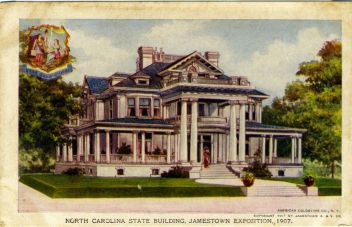
The Jamestown Exposition of 1907 marked the threehundredth anniversary of England's first permanent American settlement at Jamestown, Va. Held along two miles of the Norfolk, Va., waterfront from 29 April to 1 December 1907, the exhibition's purpose was to educate people on the growth and expansion of the United States since 1607 and to encourage American patriotism. Including North Carolina, 26 states took part in the exposition. An active participant, North Carolina provided exhibits related to agriculture, horticulture, textile manufacturing, mining, tobacco, furniture, lumber, and pottery, as well as contributing the North Carolina Historical Exhibit in the exposition's Palace of History.
Three women curated and maintained the North Carolina Historical Exhibit, one of only two state exhibits organized by women. Mrs. Lindsay Patterson, the North Carolina vice president general of the Daughters of the American Revolution, planned the exhibit. Patterson and two assistants organized a statewide collection campaign, locating numerous artifacts dating from the colonial and revolutionary periods of the state's history. The women used funds allocated from the state legislature and the North Carolina Historical Commission for the project, and representatives in each of the state's major cities helped organize the collection of the "relics." All of the artifacts, including a large exhibit on Moravian life organized by the Wachovia Historical Society, were assembled into an exhibit describing the history of North Carolina's settlement and growth.
The exhibit included many paintings of important historical figures from North Carolina's early history. The walls were hung with images of the state's three signers of the Declaration of Independence (William Hooper, John Penn, and Joseph Hewes), as well as copies of John White's drawings of North Carolina's native peoples. Silver items, pieces of furniture, manuscripts, miniatures, Revolutionary War-era weapons, and clothing and other textiles were packed into the exhibit space. Many of the items were directly associated with notable events, historical places, or important characters in the state's history. The exhibit featured a silver teaspoon owned by William Hooper, a miniature portrait of Judge James Iredell, and a full-size portrait of Winifred Hoskins, secretary of the Edenton Tea Party. Signed letters from the Marquis de Lafayette and the gun owned by Governor Jesse Franklin (who fought at the Battle of Guilford Courthouse in 1781) were displayed as well. The exhibit also represented women as important participants in early North Carolina history by including a china plate owned by Edenton Tea Party participant and tavernkeeper Elizabeth Horniblow, a glass cologne bottle owned by Dolley Payne Madison, and the white satin slippers of the wife of Governor James Turner (1802-6).
For their efforts, the organizers of North Carolina's Historical Exhibit won a silver medal of merit. Many of the "relics" were returned to their owners, but some of the artifacts were preserved in the collection of the North Carolina Museum of History in Raleigh.